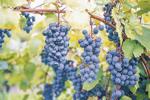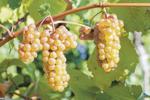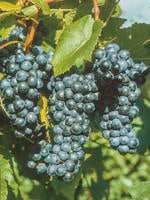Hybrid grapes were once a mainstay of the Finger Lakes wine industry, but after Dr. Konstantin Frank showed that Vitis viniferavarieties could be grown here, French and North American hybrid grapes gradually receded into the background. They are, however, still present and produce wines that some people still quite like. Why were they developed in the first place?
An infestation of phylloxera aphids in Europe after 1858 threatened to wipe out the many varieties of the wine-producing grape species V. vinifera and thus the wine industry. One European response was to create hybrids between V. vinifera and various Vitis species from North America. The grape phylloxera originated in North America and the native grape species here had evolved a sticky sap in their roots that clogs the mouth parts of the aphids and prevents the bug from girdling them.

De Chaunac grapes
Plant hybridization was established as a scientific practice in 19th century Europe, and was being explored generally in agriculture. By 1873, both Scottish and German scientists had crossed grain species wheat (Tritcum) with rye (Secale) to produce triticale (although it would not be commercially viable until the 1930s). But the idea was the same — combine the positive characteristics of two species to make a better one. In the case of the wine-producing grape, French scientists wanted a plant that produced fruit that made wine that was as good as that made from V. vinifera, and had roots that were resistant to phylloxera. The wine industry tried the hybrids, but the permanent fix proved to be grafting European vinifera varieties onto American rootstock hybridized to tolerate European soil and remain resistant to phylloxera.
However, during the 1860s, French viticulturist Albert Seibel and his company produced 500 hybrid varieties that were suitable for cultivation and several of these — Aurore (Seibel 5279), Chancellor (Seibel 7053), Chelois (Seibel 10878) and De Chaunac (Seibel 9549) — are still used for wine production in the Finger Lakes. In the early 20th century, Seibel’s hybrids were cross-bred by father and son Bertille and Johannes Seyve and Bertille’s father-in-law Victor Villard to produce a second generation of hybrids, including Seyval blanc, Chambourcin, and Villard noir. Initially embraced by the French, they were then rejected and torn out and finally made illegal in the 1970s. Their resistance to cold, however, caused them to be popular in the U.S. Northeast and Midwest and in Canada.
In 1969 when Dave Peterson’s father established his grape-growing farm on 20 acres in Fayette, he grew mostly Aurore, a Seibel hybrid, for the Taylor wineries. Peterson says that it became a dominant grape for Taylor because it was harvested early, which fit their production schedule. Furthermore, it didn’t have the “foxy” flavor of the native grapes. But the popularity of Taylor wines declined through the 1970s, and by 1985 Peterson had planted Ravat 51, Catawba, and Ventura and opened his own winery, Swedish Hill, which has since multiplied to produce Goosewatch and then Penguin Bay.

Vignoles
Ravat 51 (often called Vignoles) is a second-generation cross between a Seibel grape and an unknown vinifera. Catawba is a native hybrid of unknown origin. Ventura was developed in 1951 in Canada by crossing Elvira, a 19th century hybrid developed in Missouri, and Chelois, a Seibel grape.
In spite of their hardiness, hybrid grapes are not without their challenges. Peterson said that Chambourcin, a second-generation French hybrid whose true parentage is not preserved, can not be planted on a site with early frosts and is not much more cold-hardy than Cabernet Franc. It also tends to produce too many grapes (“over-cropping”), a frequent criticism of hybrids and an expression of “hybrid vigor.”
Peterson once thought of Vignoles as “promising” but now regards it as a pain in the neck. “We can grow Riesling just as easily,” he said, “and [Vignoles] is much more prone to bunch rot, although it is winter hardy.” He isn’t planting more of it, but is much more inclined to use it for making ice wine.
I asked about Maréchal Foch, a French hybrid developed in 1910. Peterson makes this deeply red wine at Swedish Hill, but doesn’t grow it, and he said there isn’t a lot left in the Finger Lakes. Its biggest challenge is bird predation. “Growers have fits,” Peterson said, “and no one wants to use nets because of the cost.” Winemakers like it as a component, he said, because it smells good. It is very fruity, but not tannic and has very high pH.
Baco noir, a hybrid developed in the early 20th century in southwestern France by François Baco, was brought to the U.S. during prohibition by Philip Wagner, a Maryland journalist and amateur winemaker, along with several other French hybrids. John Leidenfrost’s father planted eight acres of Baco noir in 1962. Like Peterson’s father, the elder Leidenfrost sold grapes, but to Gold Seal. In addition to the Baco noir, he had 30 acres of Catawba and three acres of Cayuga, a Cornell hybrid, which Great Seal made into “champagne.”

Noir grapes
But like the Petersons, the Leidenfrosts began to make their own wine. “We made it darker than dark,” said Leidenfrost of Baco noir. “We let it get ripe and picked it at 25 Brix [sugar content].” At first he tried to “soften” the wine by adding oak chips to the blue barrels, but it did not have the desired effect. Then he attended a conference in Oregon. “I was in a booth next to a guy who made Baco,” Leidenfrost recalled. “He told me to put it in oak barrels and let it sit for two years. ‘Micro-oxygenation’ converts the malic acid via malolactic fermentation. He told me to use barrels that were more than eight years old.”
Fifteen years ago Leidenfrost mixed Baco noir in equal parts with Pinot noir and called it “Baco Beaujolais.” Federal authorities informed him that because his grapes were not from the Rhône Valley he could not call them Beaujolais. So, he made straight varietal Baco noir instead, which was well received.
Peterson still grows hybrids and bottles some of them as varietals, but blends many into his sweeter wines, which remain popular. He has replaced older hybrids, like Baco noir and de Chaunac, with newer ones: Noiret, Corot noir, and Marquette. Cornell is now breeding for “no spray” hybrid grapes, which he said the public wants for health reasons and the growers want because fungicide is expensive.
After 2002, Leidenfrost tore out most of his hybrids. The Baco noir was beset with ringspot virus. His Vignoles wasn’t doing well in his porous soil. He has kept some Cayuga, but has replaced most of his hybrids with European varieties. “My farm is prime for vinifera,” he said. “The temperatures on the east side of Seneca are perfect. I’m in the middle of the banana belt.”
And with Dr. Frank’s truth confirmed, the hybrids keep playing, but have moved to the back of the orchestra.
The Link LonkJune 25, 2021 at 08:30AM
https://ift.tt/3qnpmtz
The Rise and (Not Quite) Fall of Hybrid Grapes - ithaca.com
https://ift.tt/3eO3jWb
Grape

No comments:
Post a Comment